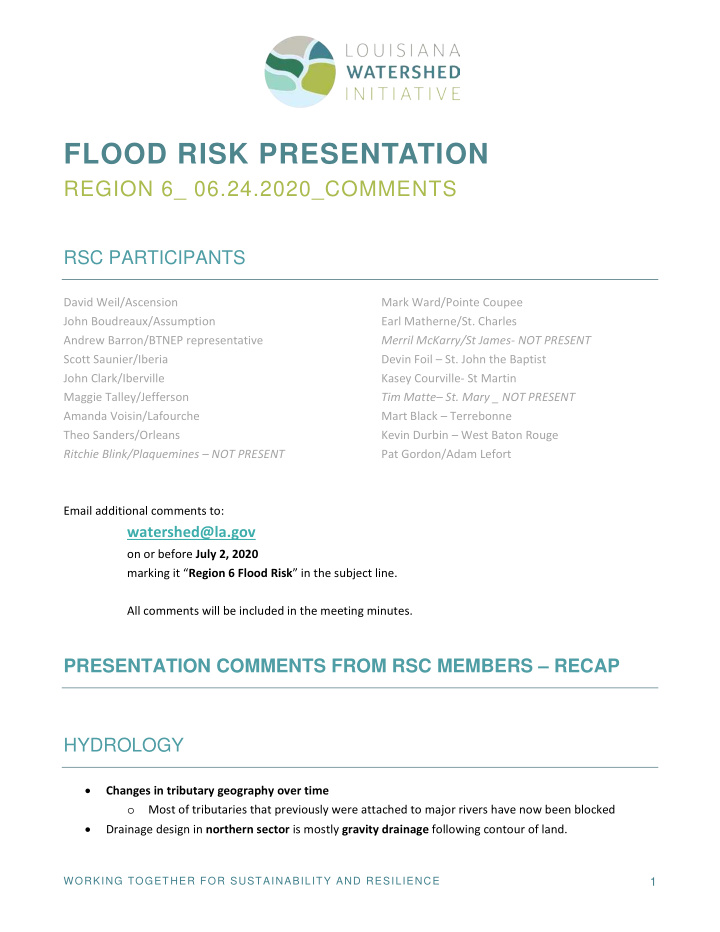



FLOOD RISK PRESENTATION REGION 6_ 06.24.2020_COMMENTS RSC PARTICIPANTS David Weil/Ascension Mark Ward/Pointe Coupee John Boudreaux/Assumption Earl Matherne/St. Charles Andrew Barron/BTNEP representative Merril McKarry/St James- NOT PRESENT Scott Saunier/Iberia Devin Foil – St. John the Baptist John Clark/Iberville Kasey Courville- St Martin Maggie Talley/Jefferson Tim Matte– St. Mary _ NOT PRESENT Amanda Voisin/Lafourche Mart Black – Terrebonne Theo Sanders/Orleans Kevin Durbin – West Baton Rouge Ritchie Blink/Plaquemines – NOT PRESENT Pat Gordon/Adam Lefort Email additional comments to: watershed@la.gov on or before July 2, 2020 marking it “ Region 6 Flood Risk ” in the subject line. All comments will be included in the meeting minutes. PRESENTATION COMMENTS FROM RSC MEMBERS – RECAP HYDROLOGY • Changes in tributary geography over time o Most of tributaries that previously were attached to major rivers have now been blocked • Drainage design in northern sector is mostly gravity drainage following contour of land. 1 WORKING TOGETHER FOR SUSTAINABILITY AND RESILIENCE
• In southern sector, forced or pump drainage . • Mitigating factors have included buyouts, relocations, retrofitting, and flood insurance regardless of location. Many portions of this region have dealt with flooding issues for a long time. • Relational drainage from different sectors of the region o Bottom portion of this region deals with drainage from upper portions of region. o Regional approach offers comprehensive best practices implementation opportunity • Andrew/BTNEP: o Flat aspects of southern part of region means water flows away from the larger waterways, and larger waterways form hydrologic boundaries o Bidirectional flow – ex. Bayou Folse watershed – offer unique issues related to flood protection o Fresh water isn’t all about drainage . Reverse flow signatures in northern part of Barataria Basin can then mean drainage solutions can then become negative impacts. o Forced drainage: over 256 in Barataria/Terrebonne system in last survey – drainage system projects can work with flood protection efforts. BTNEP has developed such approaches in past . SURGE DATA/COASTAL RISK • Many of our communities use surge data to inform mitigation activities. Developers anxiously awaiting these updates . Will enhance or take away from potential developments going forward. • John Boudreaux/Assumption: Surge data includes some datasets that are not that accurate as you move inland . Cat 5 storms, for instance in Belle Rose area – difficult to model inland with our terrain in this area. Caution against utilization of data inland. We’ve seen that with Hurricane Andrew, etc. • Northern Assumption - Lake Verret, Belle River locations for further zooming in for later discussion • CPRA master plan overlap with Region 6 provides resource . Note: 14 of the 20 parishes in the Region 6 group. So only 2 of our parishes are not in that master plan. Can share information. • LWI to do transition modeling to blend riverine modeling with coastal modeling FLUVIAL/PLUVIAL/BACKWATER FLOODING • Iberville area is “stuck in the middle” – multiple types of flooding risk . Riverine issues at Morganza, then additional riverine issues as come down between the two levees through lower portions of parish, with backwater and bidirectional issues as well. Benchmarks subsiding 1.5 feet recently – Bayou Chene area working to prevent backwater issues. 10,000 cubic feet per second flow upstream issue. LOUISIANA WATERSHED INITIATIVE 2
REPETITIVE STRUCTURE DATA • No structure falls off the RL list, so we really need to be very strategic about the use of the list. FEEDBACK ON FEMA FLOOD ZONES & RISK • Modeling tools prompt discussion of what standards should be in place for community protections o Cindy O’Neill: maps show areas flooding that were not in the SFHA were likely not regulated by the communities. That should be an indication that we should be enforcing higher standards to protect them. 50% less flooding if we had adopted 1-foot freeboard suggestions. o Kevin Durbin: we do have higher standards in WBR; that particular event was higher than a 500- year event, so what level of an event should we hold a standard for? o Evelyn Campo: a lot of our data is backward facing. RSC may want to review near-miss data as well to be more forward-facing. WORKING WITH NATURE • Consider expansion of wetland space. Need to also look at some of the prime property for use as reservoirs, not just existing wetlands. LOUISIANA WATERSHED INITIATIVE 3
Recommend
More recommend